Measurement of Charm and Beauty Photoproduction at HERA
using D* mu Correlations
|
Introduction
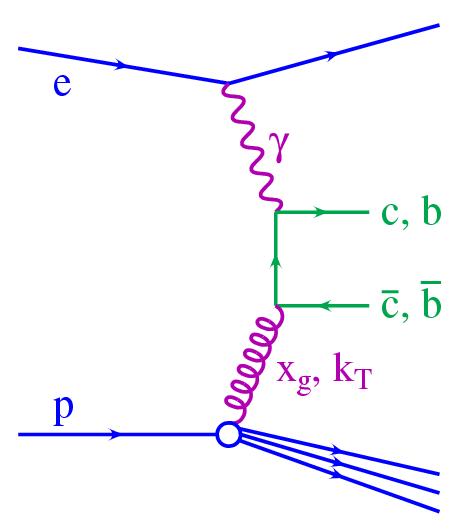 Measuring heavy quark production in ep collisions at HERA
is an ideal testing ground for studying the strong force.
At HERA heavy quarks are predominantly produced via
photon-gluon fusion, which is illustrated in the diagram on the
right hand side.
This process is directly driven by the gluon density g(xg)
in the proton, where xg is the relative momentum
fraction of the gluon with respect to the total proton momentum.
The large mass of the heavy quark provides a hard kinematical scale,
which allows the calculation of cross sections
by means of perturbative-Quantum-Chromo-Dynamics (pQCD).
The heavy quark production cross section is largest for
photoproduction, i.e. for photons with virtuality
Q2 approximately 0.
The light quarks u,d and s are produced much more copiously
than c and b, and beauty production is suppressed by a
factor of approximately 200 compared to charm.
Charm and beauty measurements performed at HERA so far relied
on the tagging of only one heavy quark in each event.
While the charm measurements were mostly based on the
reconstruction of D mesons, the beauty measurements used
semi-leptonic decays or lifetime signatures or both.
In this analysis both heavy quarks are tagged in a large
fraction of events using a D* and a muon as signatures.
Measuring heavy quark production in ep collisions at HERA
is an ideal testing ground for studying the strong force.
At HERA heavy quarks are predominantly produced via
photon-gluon fusion, which is illustrated in the diagram on the
right hand side.
This process is directly driven by the gluon density g(xg)
in the proton, where xg is the relative momentum
fraction of the gluon with respect to the total proton momentum.
The large mass of the heavy quark provides a hard kinematical scale,
which allows the calculation of cross sections
by means of perturbative-Quantum-Chromo-Dynamics (pQCD).
The heavy quark production cross section is largest for
photoproduction, i.e. for photons with virtuality
Q2 approximately 0.
The light quarks u,d and s are produced much more copiously
than c and b, and beauty production is suppressed by a
factor of approximately 200 compared to charm.
Charm and beauty measurements performed at HERA so far relied
on the tagging of only one heavy quark in each event.
While the charm measurements were mostly based on the
reconstruction of D mesons, the beauty measurements used
semi-leptonic decays or lifetime signatures or both.
In this analysis both heavy quarks are tagged in a large
fraction of events using a D* and a muon as signatures.
The correlations between the direction of the muon with
respect to the D* and their electric charges are used to
separate charm and beauty contributions.
The measurement of the b cross section presented here extends
to significantly lower centre-of-mass energies of the
b-pair system than previous measurements at HERA. The
simultaneous detection of the D* meson and the muon makes
possible new tests of higher order QCD effects.
For instance, in the photon-gluon rest frame the angle between
the heavy quarks is 180o at leading order, but
at next-to-leading order it can differ significantly from
this value due to hard gluon radiation. Furthermore, the D*muon
pair is expected to be sensitive to a possible transverse momentum
kT of the gluons entering the quark pair production
process.
Experimental technique
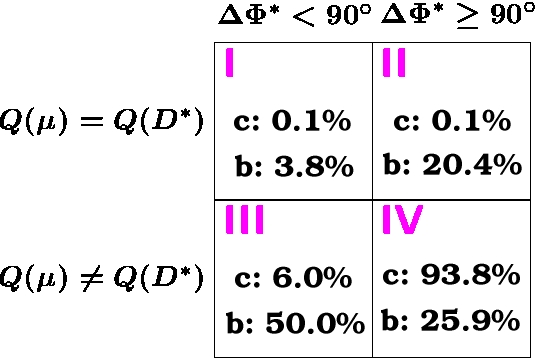
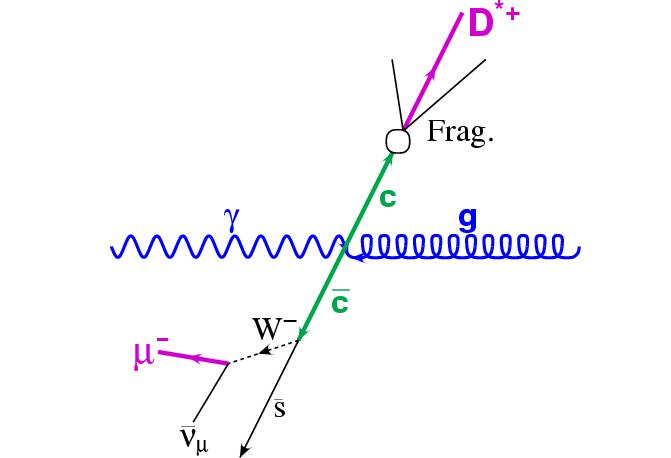
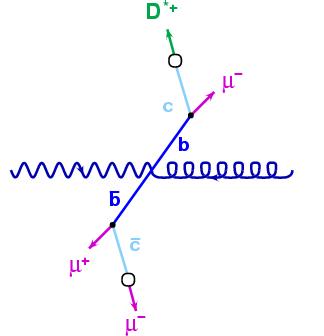 In this measurement only D* events decaying into a D0 and
a slow pion, where the D0 decays than itself into a charged
kaon and pion, are considered. Muons are required to be identified in
the instrumented iron.
In this measurement only D* events decaying into a D0 and
a slow pion, where the D0 decays than itself into a charged
kaon and pion, are considered. Muons are required to be identified in
the instrumented iron.
In order to separate charm and beauty contributions the charge and
azimuthal angle correlations of the D* meson and muon are exploited.
The azimuthal angle difference between the D* and the muon and their
respective electric charges are used to define for 'correlation regions'
I-IV. This is sketched in the upper left plot. The four regions are
populated differently by charm and beauty events. The values indicated
in this figure are obtained with PYTHIA without detector effects.
Neglecting any transverse momenta of the photon and the gluon, the
photon-gluon fusion process leads to a back-to-back configuration of
the two quarks (see middle and right upper plot). Approximating the
directions of the D* meson and the muon with those of the quark and
antiquark and selecting opposite charges, charm pair events populate
correlation region IV. In contrast, beauty events populate regions II,
III and IV, depending on whether the muon originates from the same b
quark as the D* or from the opposite anti-b (see upper right figure).
If the muon originates from the same b quark as the D* meson, the events
lie in region III. For muons coming from the anti-b opposite to the D*
meson, the direct decay populates region II, while the cascade process
populates region IV. Region IV hence receives contributions from both
charm and beauty events and region I stays empty.
The azimuthal angle correlations are smeared by fragmentation and
semileptonic decay processes and by higher order QCD effects such as
gluon radiation and any initial transverse momentum of the gluon. According
to the PYTHIA Monte Carlo simulation, which takes into account these
smearing effects, the relative population of the four region is as given
by the numbers in the upper left figure. These numbers apply in the analysed
kinematic region and do not include detector effects.
Finally the charm and beauty contributions in the data are determined by
performing a simultaneous likelihood fit of the mass difference of the D*
and D0 candidate in each correlation regions.
Results
The total measured cross section for charm in the visible kinematic
region is in agreement with the NLO QCD prediction, while the beauty
cross section is higher than predicted. The kinematic region of the
latter is characterised by lower b anti-b centre-of-mass energies than
in the most previous analyses, which require high momentum jets.
Differential cross sections for D*muon production in the visible kinematic
region are evaluated as a function of variables characterising the D* meson,
the muon and the D*muon system. For theses distributions the complete data set,
which contains the contributions from charm and beauty, are used. The lower left
plot shows exemplarily the D*muon cross section as a function of the azimuthal
angle difference between the D* meson and the muon. The QCD calculations including
higher order effects (indicated in the left plot with FMNR) show general agreement
with the shape of the data. Effects beyond the LO approximation are directly observed.
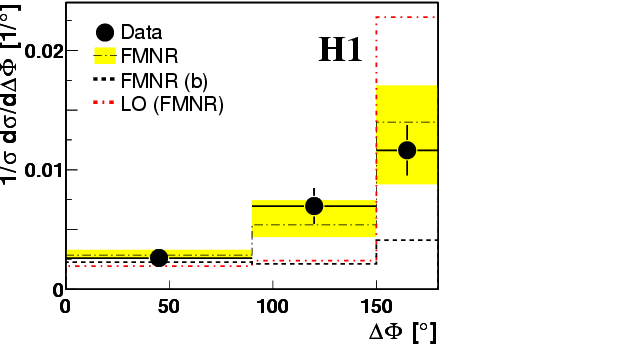
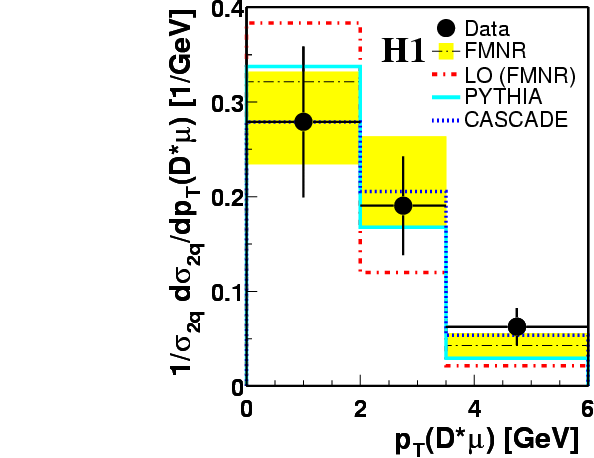
In addition differential cross sections for D*muon production are determined
for a smaller sample, where both the heavy quarks are tagged by either a D*
or a muon. For this purpose correlation region IV is used, which is dominated
by charm. The dilution of the correlation of quantities characterising the
quark pair and the measured D*muon pair as obtained for the complete data
sample due to the events from correlation region II in which both D* and muon
originate from the same b quark is avoided in this smaller sample. The upper
right plot shows exemplarily the D*muon cross section of the quark-antiquark
tag sample as a function of the transverse momentum of the D*muon pair, which
is related to a possible tranverse momentum of the initial gluon kT.
In the kinematic region studied, effects due to kT factorisation,
as implemented in CASCADE, are found to be small compared to the experimental
errors.
What did we learn
The total measured cross section for charm in the visible kinematic
region is in agreement with the NLO QCD prediction, while the beauty
cross section is higher than predicted. The kinematic region of the
latter is characterised by lower b anti-b centre-of-mass energies than
in the most previous analyses, which require high momentum jets.
Comparisons of the shapes of the measured differential distributions
with the QCD calculations including higher order effects show general
agreement. Effects beyond the LO approximation are directly observed.
 Measuring heavy quark production in ep collisions at HERA
is an ideal testing ground for studying the strong force.
At HERA heavy quarks are predominantly produced via
photon-gluon fusion, which is illustrated in the diagram on the
right hand side.
This process is directly driven by the gluon density g(xg)
in the proton, where xg is the relative momentum
fraction of the gluon with respect to the total proton momentum.
The large mass of the heavy quark provides a hard kinematical scale,
which allows the calculation of cross sections
by means of perturbative-Quantum-Chromo-Dynamics (pQCD).
The heavy quark production cross section is largest for
photoproduction, i.e. for photons with virtuality
Q2 approximately 0.
The light quarks u,d and s are produced much more copiously
than c and b, and beauty production is suppressed by a
factor of approximately 200 compared to charm.
Charm and beauty measurements performed at HERA so far relied
on the tagging of only one heavy quark in each event.
While the charm measurements were mostly based on the
reconstruction of D mesons, the beauty measurements used
semi-leptonic decays or lifetime signatures or both.
In this analysis both heavy quarks are tagged in a large
fraction of events using a D* and a muon as signatures.
Measuring heavy quark production in ep collisions at HERA
is an ideal testing ground for studying the strong force.
At HERA heavy quarks are predominantly produced via
photon-gluon fusion, which is illustrated in the diagram on the
right hand side.
This process is directly driven by the gluon density g(xg)
in the proton, where xg is the relative momentum
fraction of the gluon with respect to the total proton momentum.
The large mass of the heavy quark provides a hard kinematical scale,
which allows the calculation of cross sections
by means of perturbative-Quantum-Chromo-Dynamics (pQCD).
The heavy quark production cross section is largest for
photoproduction, i.e. for photons with virtuality
Q2 approximately 0.
The light quarks u,d and s are produced much more copiously
than c and b, and beauty production is suppressed by a
factor of approximately 200 compared to charm.
Charm and beauty measurements performed at HERA so far relied
on the tagging of only one heavy quark in each event.
While the charm measurements were mostly based on the
reconstruction of D mesons, the beauty measurements used
semi-leptonic decays or lifetime signatures or both.
In this analysis both heavy quarks are tagged in a large
fraction of events using a D* and a muon as signatures.




